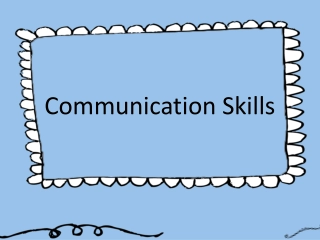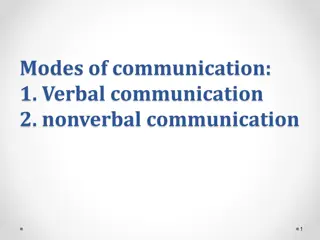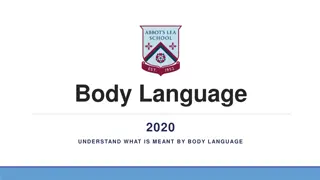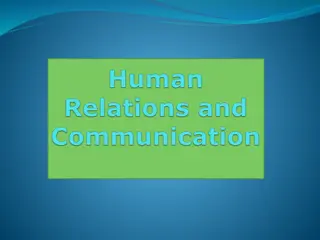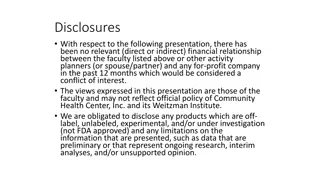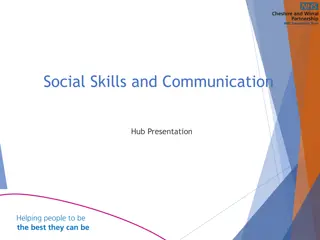Understanding the Importance of Nonverbal Communication in Communication Skills
Nonverbal communication plays a crucial role in conveying messages and signals through platforms like eye contact, facial expressions, gestures, posture, and spatial distance. It includes appearance, body language, silence, time, and space. This form of communication can significantly impact the reception of verbal messages, with studies suggesting that a significant portion of a message's effect stems from nonverbal cues. The appearance of various elements, from written messages to personal attire, conveys nonverbal impressions that influence attitudes even before the verbal content is processed. Paying attention to personal appearance and surroundings can enhance the effectiveness of verbal communication.
Download Presentation

Please find below an Image/Link to download the presentation.
The content on the website is provided AS IS for your information and personal use only. It may not be sold, licensed, or shared on other websites without obtaining consent from the author. Download presentation by click this link. If you encounter any issues during the download, it is possible that the publisher has removed the file from their server.
E N D
Presentation Transcript
NONVERBAL COMMUNICATION By Dr. Nadeem Khan Lecturer IER, University of Peshawar Semester: 2nd Subject: Communication Skills
Nonverbal Communication Nonverbal communication is the transmission of messages or signals through a nonverbal platform such as eye contact, facial expressions, gestures, posture, and the distance between two individuals Nonverbal Communication includes: Appearance, Body Language, Silence, Time and Space Numerous articles and books have been written on the importance of nonverbal messages. Some studies suggest that from 60 to 90 percent of a message effect comes from nonverbal cues
How Appearance Communicates: Appearance conveys nonverbal impressions that effect receivers attitudes towards the verbal message even before they read or hear them The format, neatness and language of a written message sends a nonverbal message to the reader An envelope s appearance-size , colour , weight , postage-may impress the receiver as important, routine Express Mail and Private Courier Mail also have distinctive envelopes that signal urgency and importance. Next the letter ,report, or title page communicates nonverbally before its contents are read by the kind of paper used, its length, format and neatness
Finally, the language itself, aside from its content, communicates something about the sender. Is it carefully worded and generally correct in mechanics; such as, spelling, grammar and punctuation? Whether you are speaking to one person face to face or to a group in a meeting, personal appearance and the appearance of your surroundings convey nonverbal stimuli that affect attitudes towards your spoken words
Clothing, hairstyles, neatness, jewelry, cosmetics, perfumes, posture, stature are part of personal appearance. They convey impressions regarding occupation , age , nationality , social and economic level, job status, and good or poor judgment, depending upon circumstances Aspects of surroundings include room size, location, furnishing, machines, architecture, wall decorations, floor (carpeted or bare?), lighting, windows, view, and other related features wherever people communicate orally. Surroundings will vary according to status and according to country and culture
How Body Language Communicates: Included under body language are facial expressions, gestures, posture and movement, smell and touch, voice and sounds (Facial Expressions)The eyes and faces are especially helpful of communicating nonverbally. They can reveal hidden emotions, including anger, confusion, enthusiasm, fear, joy, surprise, uncertainty and others. They can also contradict verbal statements
Gestures, Postures and Body Movements: Gestures and movements are culture specific. The meaning of gesture in the United States may be completely different in Europe or Asia In the United States, a clenched fist pounding on the table can indicate either anger or emphasis. Such a display in Asia would be unacceptable Continual gestures and movement; such as, pacing back and forth may signal nervousness and may be distracting to listeners. Handshakes reveal attitudes
Legs too communicate nonverbal messages. Consider for example a man sitting with his legs stretched out on top of his desk during an interview; a person shifting one leg to the other in rhythmic motion; a woman pacing back and forth while speaking Posture and movement can convey self-confidence, status or interest. A confident executive may have a relaxed posture, and yet may stand more erect than a timid subordinate. An interested listener may lean forward towards the speaker; one who bored may lean away or glance at the clock
Smell and Touch: Various odors and fragrances sometimes convey the emotions of sender and sometimes affect the reactions of the receiver, especially if the receiver is sensitive to scents Also ,touching can communicate friendship, love ,approval, hatred, anger or other feelings A kiss on the cheek ,pat on the shoulder, or slap on the back is prompted by various emotions
On the other hand ,touching in a crowded Japanese train or being pushed at the Tsimshatui mass transit railway in which passengers are squeezed together may be offensive to many North Americans
Voice and Sounds: Your voice quality and extra sounds you make while speaking are also a part of nonverbal communication called paralanguage. Paralanguage include voice ,volume, rate, articulation, pitch and other sounds you may make; such as, throat cleaning and sighing A loud voice often communicates urgency while a soft one is sometimes calming Speaking fast may suggest nervousness or haste. A lazy articulation, slurring sounds or skipping over syllables or words may reduce credibility
A lack of pitch variation becomes monotone, while too much variation can sound artificial or too much dramatic Throat clearing can distract from spoken words Emphasising certain words in a sentence can purposely indicate your feeling about what is important
How Silence, Time and Space Communicate: Silence Consider how you feel when you make an oral request that is met with silence or think about the confusion you feel when your written message generates no response. You may think that the answer is negative when it takes several weeks. The person may be busy and has not been able to answer you. You may also consider that the person is not answering because he/she is considering your request unworthy to answer
Time: Waiting when an important request is ignored causes problems and attitude changes. How do you feel when you are kept waiting two hours after the scheduled time for an interview? In US culture ,being on time for appointments, for work each day ,and for deadlines communicates favourable nonverbal messages Concepts of time, however, vary across cultures and even in the US. Americans and Germans for example are quite punctual
Middle Eastern business people think little of arriving after agreed upon time, not out of discourtesy but rather a feeling that the task will be accomplished regardless of time If you arrived on time for a meeting in Portugal, your host might wonder why you come so early
Space: If you step into an empty elevator, where do you stand? If the elevator then fills up with people, where do you move? The need for personal space decreases as the number of people increases In the United States, the need for personal space in a two-person conversation is about 18 inches. The need for space is less in many middle eastern countries and more in most Scandinavian Countries







